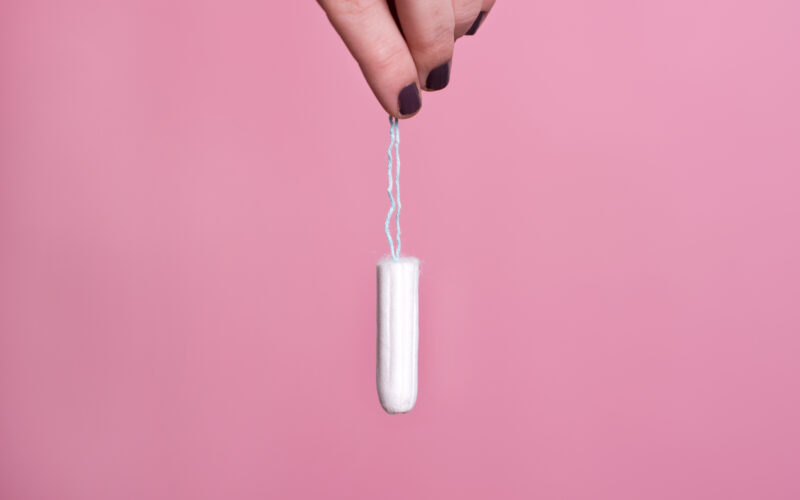Tampons: love them or hate them. For some women, the idea of sitting on a pad all period long is unimaginable. There’s the blood smell, the squelchy feeling of a pad that gets too full, and the overall feeling of wearing a somewhat-streamlined version of an adult diaper.
For other women, a tampon is simply far more trouble than it’s worth. Some women experience pain with tampon use. There’s also the risk of using a tampon on a too-light day and upsetting the sensitive vaginal wall. Others may fear a tampon getting stuck or causing toxic shock syndrome (TSS) (although, thankfully, with modern tampon designs and lower absorbency levels, TSS is largely a thing of the past). But while women can safely use tampons without being worried about a dangerous bacterial infection, new research from UC Berkeley reveals a different risk of being on Team Tampon: heavy metal exposure.
Researchers tested whether name-brand and generic tampons contained arsenic, lead, mercury, and more
The researchers previously published a review of literature in which they found that tampons had tested positive for “dioxins and furan congeners, polycyclic aromatic hydrocarbons (PAHs), fragrances, phthalates, parabens, bisphenols, triclocarban, glyphosate, flame retardants, and volatile organic compounds (VOCs) (Upson et al., 2022)” [1]. But this recent study was the first of its kind to test tampons specifically for heavy metals.
The study analyzed the levels of 16 different metals in 30 tampons representing 14 brands and 18 product lines [1]. The metals measured were arsenic, barium, calcium, cadmium, cobalt, chromium, copper, iron, manganese, mercury, nickel, lead, selenium, strontium, vanadium, and zinc. Researchers bought tampons from different regions (the United States, Europe, and the United Kingdom), different brands (including comparing store-brand and name-brand), and tested tampons made with organic and non-organic material. The metals assessed included more toxic metals (like arsenic, lead, mercury, and cadmium) and less toxic metals (like iron, copper, and zinc).
All 16 different metals were found in measurable levels in their study, but the concentrations of these metals differed by category. While the metal levels varied, there was no category with lower overall metal concentrations. For example, lead concentrations were higher in non-organic tampons, but organic tampons measured higher in arsenic concentrations.
Lead was detected in every tampon sampled
While some tampons tested positive for certain metals but not others, every single one tested positive for lead [1]. This is troubling because there is no established safe level of lead exposure, and lead exposure is associated with kidney, brain, heart, immune, reproductive, and developmental problems [2].
Why are metals in tampons?
Tampons are made of cotton, rayon, or a blend of both. According to UC Berkeley, cotton can absorb metals from contaminated water, air, or soil, especially if the cotton is grown near an area that produces or processes heavy metals. Metals could also be introduced during the manufacturing process to bleach the cotton or as an antibacterial agent, although the Center for Baby and Adult Hygiene Products has stated that intentionally adding these chemicals during manufacturing is not permitted in products sold in the US.
How concerning are these metals?
We don’t yet know just how concerned we should or shouldn’t be about these findings. The study specifically highlighted the need for future research to determine whether and how much these metals cross the vaginal epithelium (outer layer of the vagina) into the bloodstream and thus affect the rest of the body.
This research is crucial as tampons are one of the most popular menstrual products on the market, meaning that millions of women could be affected. Even if metal absorption turns out to be relatively low, tampons are kept inside the body for hours at a time, for multiple days, month after month, year after year–meaning that metal levels could theoretically build up over time. Concerningly, without medical intervention, metals will not leave the body on their own, which is why animals higher up in the food chain (like swordfish and shark) tend to contain high levels of metals like mercury.
We also recently covered a 2023 Chinese study on the connection between heavy metal exposure and endometriosis, which concluded that heavy metals both “individually and as a mixture, play a role in the risk of endometriosis” [3]. This seems to be a particularly relevant finding in light of the UC Berkeley’s study’s tampon toxicity findings.
What are the signs of heavy metal toxicity?
According to Cleveland Clinic, heavy metals can accumulate in body tissues and interfere with normal cell functions. While symptoms vary from metal to metal, common symptoms of metal poisoning include abdominal pain, chills, dehydration, diarrhea, weakness, nausea, vomiting, scratchy throat, and numbness or prickling in the hands and feet. Severe metal poisoning can cause permanent organ damage, harm fetal development, and increase the risk of developing cancer.
The treatment for heavy metal poisoning also depends on the type of metal exposure but often involves chelating agents that help to remove metal from your body via urine.
Ways to reduce period product toxin exposure
The first place I heard about the Berkeley study was from the reusable menstrual product company June, offering a sale on their menstrual cups and discs for people looking to make the switch from tampons. Reusable menstrual products are made of medical-grade silicone and sidestep the environmental contamination concerns that come with using cotton-based products. Menstrual cups and discs are also a good way to save money and reduce waste since a $8–$35 product can be used safely for several years. (Personally, I’m partial to menstrual discs as I find them easier to use than menstrual cups, and they fit better for me after having babies!).
Another option is to use period products that have less direct contact with your body, such as pads or period underwear. While similar metal contaminants may be present in these products (pads and tampons are largely made of the same material), these products aren’t in contact with the capillary-rich environment of the vagina, which should theoretically limit potential absorption–but more research on this is also needed.
You’re not alone if you feel overwhelmed by all the ways you’re exposed to endocrine-disrupting chemicals
New research continues to become available on the dangers present in everyday products. Because plastic makes up everything from clothes to toys to many of our household products, the presence of microplastics in our homes and bodies are of concern, as they may act as endocrine disruptors. Besides the plastic itself, plastic additives like phthalates have been linked to issues like preterm birth. Other endocrine disruptors can be present as fragrances in lotions, soaps, makeup, and other personal care products [4]. And now, women also have to consider the potential exposure to heavy metals when choosing their menstrual products.
Many of us can feel overwhelmed when deciding to avoid certain chemicals or toxins, especially when more research needs to be done on how big the risk actually is. However, less is always more when it comes to endocrine-disruptor exposure. This could mean completely cutting potential risks out of your life–including plastic, perfume, and cotton-based menstrual products… but it may also look like switching to glass food storage containers instead of plastic, and using tampons for one less day each cycle. Start small, and remember not to let the perfect be the enemy of the good.
Of course, choosing an eco-friendly family planning method may be the most impactful change of all. Changing habits and exploring less mainstream options can be difficult, but every small step taken to limit toxin exposure may help safeguard your reproductive health and overall wellness.
Additional Reading:
How to “green” your period (and why you might want to)
Simple Ways to Protect Your Health and Fertility from Endocrine Disruptors
Breastfeeding: The eco-friendly baby feeding option
Having “green sex” might be the best thing you can do for the environment








I have seen that menstrual cups (and I would think disks, as well) can contribute to UTIs because of the pressure it puts on the area. The pressure of the rim of the cup presses against your urethra and can cause a backup of the bacteria that cause UTIs. What are your thoughts on this? Thanks!
Thank you for your comment! It looks like this particular problem is rare and depends on individual anatomy. If you have any issues voiding while using a menstrual cup, an easy solution would be to remove it during a trip to the bathroom. When I used menstrual cups, I would often do this anyways as bearing down would sometimes displace the up, and I would usually want to empty it out anyways while in the bathroom. Many companies also offer cups in multiple sizes to fit different anatomies and some, like Lena, offer a softer-rimmed cups for “sensitive” anatomy.